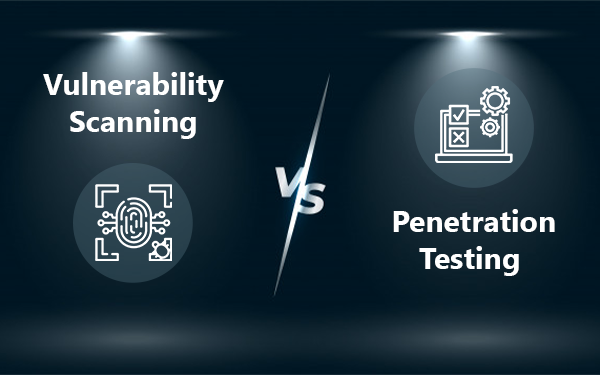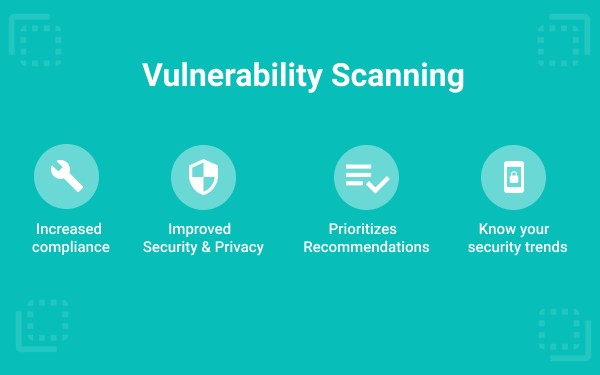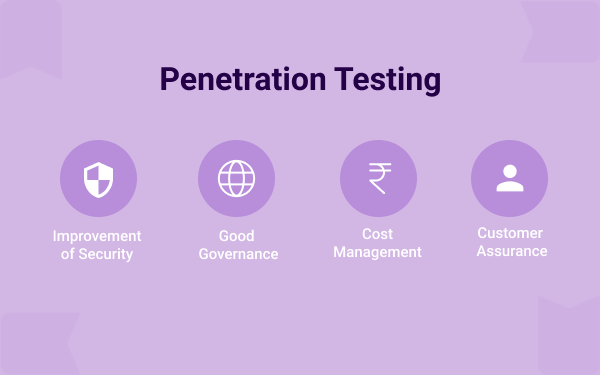
29 Jun Vulnerability Scanning Vs Penetration Testing
Vulnerability scanning and penetration testing are the two most confusing terms of the same service. However, both serve crucial but different functions necessary to protect the entire ecosystem of networks in an organization.
But, the problem arises when business owners use one when they need the other. Thus, they miss on the vital elements of a secure network.
In this blog post, we will discuss different aspects of vulnerability scanning and penetration testing. It will help you clear the confusion between the two and make things simpler and easy to comprehend.
Let’s dive deeper!
What is Vulnerability Scanning?
Vulnerability scanning is an automatic process of identifying the vulnerabilities related to the security of networks and applications. It is professionally done by the designated IT department of any organization or hackers. He checks the entry points into an organization’s network.
In the vulnerability scanning, all the network ports, password breaches, and suspicious applications are being scanned with the help of scanners configured for the same purpose.
The scanning process involves various techniques that are used to check the response that a device, network, or application gives within the target scope.
Based on the output from the device, the scanner tends to match the results to the database and assign risk ratings accordingly.
This way, the scanning services tend to point out needed security fixes, missing service packs, coding flaws, or other malware.
Benefits of Vulnerability Scanning

Vulnerability scanning has its own set of benefits that help organizations identify and quantify security vulnerabilities. Some of them are mentioned below, let’s have a look:
- If we talk about the primary benefits of vulnerability scanning, then it figures out the known security exposure before a hacker could make out the easy way to entry points.
- It helps you identify the vulnerabilities associated with specific devices and the entire network as you create an inventory of devices on the network. The purpose and system information is always considered while creating an inventory.
- When you create an inventory of all the devices in the organization, vulnerability scanning also helps you with a detailed assessment of needs and making upgrades as per future requirements.
- As we discussed the process of vulnerability scanning above, we know that the scanner matches the results with the database and assign risk ratings. This way, it defines the level of risk present in the targeted network.
- The best part is that once the scanners are configured, you get continued updates making it a repeatable process that secures your network and application from cyber threats.
Read Also: Guide to Penetration Testing
What is Penetration Testing?
Penetration testing or pen testing is a simulated cyberattack on your organization’s network or application, and thus, it is called ethical hacking.
Ethical hackers tend to check for exploitable vulnerabilities in a targeted network or device. They scale planned attacks against a company’s network infrastructure as a part of a holistic security strategy considering the network, device, and web apps.
Pen testing usually involves repeated attempts to breach several application systems and devices to uncover vulnerabilities such as inputs susceptible to code injection attacks.
The pen testers use specific tools and techniques that cybercriminals use in common to check the impact that an attack may leave on the business.
It helps pen testers and organizations to understand whether the system is robust enough to resist an attack from various authenticated and unauthenticated sources.
Considering the insights received after a planned attack, the security policies are upgraded and are used to fine-tune patch-detected vulnerabilities.
Benefits of Penetration Testing

Organizations generally have software and systems from the beginning with the objective of eliminating security flaws. Still, a penetration test is worth the try because it gives you a clear picture of how well you have eliminated security issues. Moreover, it comes with great benefits, out of which some are mentioned below.
Let’s have a look at them:
- Pen testing gives a clear idea of existing exploitable vulnerabilities in a given network, device, or application. Based on the criticality of the vulnerabilities, you can categorize the security flaws that would help you intelligently manage vulnerabilities and prioritize remediation.
- When it comes to security breaches, there is no permanent solution. However, pen-testing has a proactive approach that uncovers the weaknesses and lets the organization decide whether they want some extra security layers to be implemented.
- Penetration tests give you a peek into the systems that aren’t working, outdated policies, tools that are providing better ROI, and changes the security posture. We can say that it acts as a quality assurance check for the organization’s security.
- Attacks evolve with time, and so do security practices. Penetration testing helps organizations know whether they are meeting the regulatory requirements or not. Also, the auditors would know in detail whether the mandated security measures are working properly, or not.
Read Also: Risk Assessment Vs Vulnerability Assessment
What are the Key Differences Between Vulnerability Scanning and Penetration Testing?

Vulnerability scanning and penetration testing are commonly used in the cybersecurity space to protect data, reputation, and revenue against security threats.
However, both these terms are often confused with each other and misunderstood. But they are different from each other.
Let’s discuss the major points of differences:
1. Nature of Process
Vulnerability scanning relates to identifying known vulnerabilities while pen-testing scales a planned attack to exploit the weaknesses.
Vulnerability scanning is used to create both offensive and defensive cybersecurity strategies, On the other hand, penetration testing is considered an offensive cybersecurity strategy.
2. Frequency
It is best to perform vulnerability scanning at least once in three months. However, if you are looking forward to making some major changes in the network infrastructure then you may need it on a monthly or weekly basis.
Penetration testing depends on the type of test you are conducting in the organization. Usually, there are two broad categories of pen testing: internal and external testing.
Most industries require both and should be performed on a regular basis. Since it is a planned attack it requires time and resources, thus we would recommend you to conduct penetration testing at least once a year.
3. Costing
When it comes to cost, you will find various pricing models that depend on the package that a vendor offers. Moreover, the environment in which vulnerability scanning is conducted also adds up to the cost.
On average a vulnerability scanning can range from $2000-$2,500 considering the above factors and the number of IPs, servers, and applications to be scanned.
On the other hand, the cost of penetration testing majorly depends on the goal of the test as it will influence the tools, time, and resources to be used.
The reason is that the goal may double the tools and software to be used which eventually adds up to the overall cost of the exercise.
On average it costs anywhere between $4,000-$100,000. Moreover, if you go for high-quality professionals, then it may range from $10,000-$30,000.
Read Also: Cost of Penetration Testing
4. Time
Vulnerability scanning can be automated and can take up to 20-60 minutes that depends on the number of IPs to be scanned. And, web scans may take up to 2-4 hours to complete.
As we discussed above, penetration testing is a complete simulated cyber-attack using similar tools that a hacker would use, it takes more time as compared to vulnerability scanning.
It may take up 1-3 weeks depending on the number of systems tested. However, if you are testing an individual app, process, or system it will take less than one week.
5. Regulation Requirements
If we talk about the regulation requirements, then vulnerability scanning has to comply with specific standards that majorly include PCI DSS 11.2.
On the other hand, penetration testing has to comply with PCI DSS 11.3. For external testing, it is PCI DSS 11.3.1 while for internal testing it is PCI DSS 11.3.2.
6. Value
Vulnerability scanning uncovers exploitable vulnerabilities either within the network or outside the network. On the other hand, penetration testing gives you complete visibility of situations a malicious entity may cause damage or attack the system that gives a clear picture of the extent of risks associated.

Vulnerability Scanning Vs Penetration Testing- Which is Better?
Vulnerability scanning targets the known vulnerabilities and can be considered a good practice. But, it cannot give the full visibility of threats that exist in your device, applications, or network.
However, penetration testing shows the real-world attack vector as to how it will impact an organization, assets, data, humans, and physical security. Moreover, it gives you a complete picture of how effective your existing security controls are against the evolving cyberattacks.
Well, penetration tests can be expensive but are worth the effort because you are letting a professional examine every nook and corner of your entire network infrastructure. This shows that there is no possibility of compromise.
Meanwhile, if you are looking for professional pen testers, consider checking SecureTriad: a leading Penetration Testing Services Company.
Here you will get penetration testing experts who will give you a complete report of risks, considering those you can begin preventing and responding to cyber threats.


